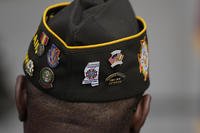A day on the water could have ended poorly for seven people, including a pregnant woman, Sept. 21 in Tampa Bay. Running into unexpected high waves, their 20-foot boat capsized, sending all into the water.
But a Coast Guard crew from Station St. Petersburg was able to rescue all safely, including those not wearing life jackets.
"This is why we urge all boaters to have life jackets with them," Capt. Mathew Thompson, commander of Sector St. Petersburg, said after the rescue.
Other searches for missing boaters this year haven't been as successful. In November, two men out for a day of fishing off Atlantic Beach, North Carolina, disappeared. Their 35-foot boat was found two days later, its lights and gear operable, but there was no sign of the missing men.
According to Coast Guard Commandant Adm. Schultz, the Coast Guard has seen a 12% uptick in search-and-rescue cases this year, an increase Schultz attributed to Americans desperate for recreation and who had "the means to buy a boat but don't necessarily have the experience or training" to operate one.
"We've been busy on that front," he said.
The service, in fact, has been "busier than ever" this year -- the side effect of a global pandemic coupled with a record-breaking hurricane season, according to the service's top officer.
As the Defense Department services deployed thousands of troops and medical personnel to cities hardest hit early on in the pandemic, the Coast Guard worked largely behind the scenes, moving to help thousands stranded on cruise ships in American waters and working with ports to make sure that vessel traffic -- including the Navy hospital ships Comfort and Mercy -- could enter and exit safely, safeguarding the global supply chain.
Read Next: The Navy is Naming its Next Frigate USS Congress
Beginning in mid-March, Coast Guard men and women were called on to help 250,000 passengers on board cruise ships when the Centers for Disease Control and Prevention issued a 'no-sail' order.
At Coast Guard Sector Miami alone, Coast Guard crews removed 150,000 passengers from ships and helped get them home, Schultz said during a virtual forum hosted by the Navy League.
Members then continued to work on that task for months, clearing "tens of thousands" of the cruise lines' employees from ships floating offshore.
"Each and every one of those was uniquely difficult, involving interaction with municipal government, port authorities, seaports, security providers and the cruise lines," Schultz said. "The Coast Guard worked very hard to repatriate those cruise passengers, those cruise ship members."
In New York and Norfolk, Virginia, Coast Guard members worked with Navy sailors to inspect the hospital ship Comfort, while other inspectors coordinated with the United States Maritime Administration to ensure sealift capability around the world.
And while the Coast Guard is always on alert during the hurricane season, this year was one for the record books, with 30 named storms, 13 of which became hurricanes, including six categorized as "major hurricanes."
Some had more of a devastating impact than others, particularly Louisiana near the Texas border, hit hard by Hurricane Laura in August and Hurricane Delta in October.
"Each and every one of [the storms] requires the same level of diligence and preparedness for folks," in locations where Coast Guard men and women not only work but live, Shultz said. "Some were personally impacted, having lost their homes or damaged their vehicles. They evacuated their families multiple times."
The increase in domestic responsibilities coincided with a renewed focus by the Trump administration on the drug trade. Following a public spat with and an indictment of Venezuelan President Nicolas Maduro on corruption and narco-terrorism charges, the U.S. upped its presence of Navy and Coast Guard ships, Coast Guard law enforcement teams and aircraft from across the military branches in the Caribbean to crack down on drug traffickers.
The operation also called for Navy ships sailing closer to Venezuela.
According to Schultz, the effort garnered a 37% increase in drug interdictions compared with seizures before the surge.
"In the last five years, the Coast Guard piece adds 2.2 million pounds of pure cocaine and 3,000 smugglers brought into the criminal justice system," Schultz said.
And of course, there are the rescues. Nearly every search-and-rescue unit in the service this year has encountered Americans in need on the water: two sports fishermen on a raft off the New Jersey Coast whose boat caught on fire; three adults and two dogs near Concord, California, who had run aground; a family trapped by the tide on a jetty in southwest Washington.
"The men and women at the pointy end of the spear at the smaller boat stations have been fully engaged," Schultz said.
Throughout the pandemic, the service has also worked hard to dodge COVID-19, Schultz said.
A few ships have been sideline by the illness, including the national security cutter Stratton, which returned to its homeport of Alameda, California, after 11 members of the 133 person crew tested positive, and the medium endurance cutter Campbell, delayed on its deployment to the northern Atlantic because of "COVID challenges."
Largely, however, Shultz said the Coast Guard has fared well during the pandemic. According to the service, it currently has 162 active cases and has had only 1,282 total cases since the start of the pandemic and no deaths -- even including the volunteer Coast Guard Auxiliary, whose members tend to be older than active-duty personnel.
"We've been blessed. I think we've been prudent. We've been lucky," Schultz said.
During the presentation, Schultz could not help but point out that the Coast Guard did not receive the same funding increases as the DoD military branches did in 2018 and continues to "scratch and claw." The Coast Guard has seen a 7.4% increase in budget versus the 23% for the U.S. Navy and explosive ordnance disposal forces, he said.
As a result, the service continues to face shortfalls in maintenance and infrastructure replacement and struggles with recruiting, Schultz said.
But with new platforms being commissioned and the service stretching the life of its older vessels, there is much of which to be proud, he said.
For example, earlier this year, the Coast Guard announced that it planned to deploy its only heavy icebreaker still in service, the Polar Star, to the Arctic for national security operations.
"She hasn't been up there in more than a quarter century, so we're really excited about projecting our heavy icebreaking capability and capacity up there," Schultz said.
-- Patricia Kime can be reached at Patricia.Kime@Monster.com. Follow her on Twitter @patriciakime
Related: This Junior Coastie Accidentally Bought Dinner For the Premier of Greenland -- and Earned a Medal














